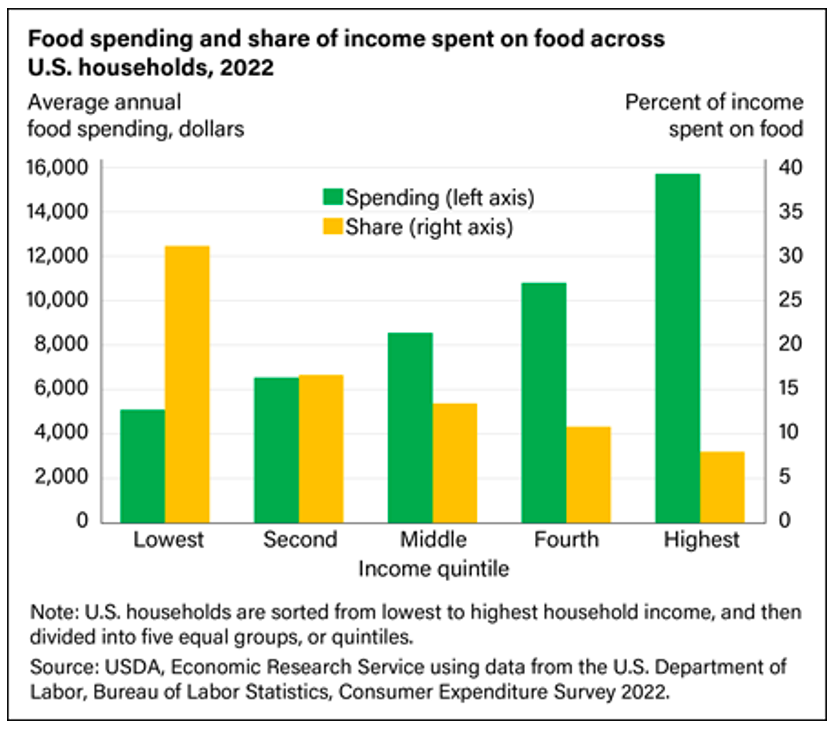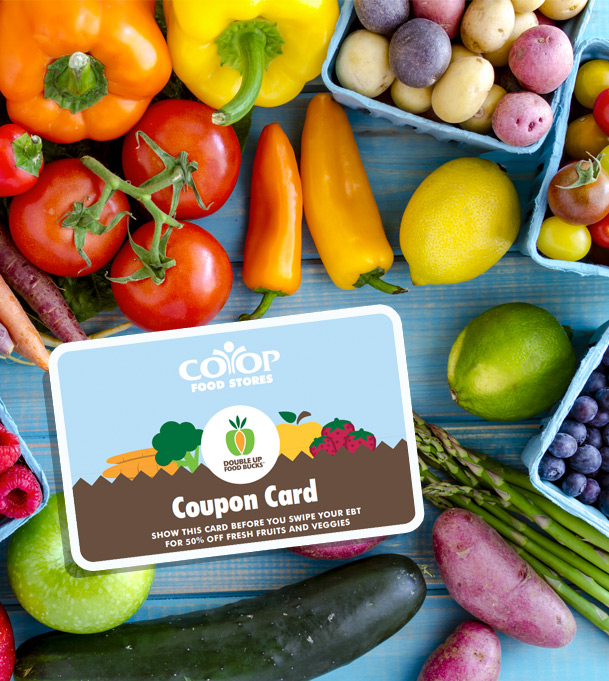The price of food—everyone is talking about it, and rightfully so! Data collected by the USDA (United States Department of Agriculture) in 2022 showed lower income households spent 31.2% of their income on food, while the highest income group spent just 8% of their income, but almost 3x as many dollars, on food.

The Bureau of Labor Statistic’s most recent Consumer Expenditure Survey (2021-2022) pointed towards food as the third highest expense for all households, after housing and transportation.
As the USDA mentions in the preamble to their findings on Food Prices and Spending, the retail price of food only partially reflects the prices seen at farm-level commodity purchasing. Other factors in bringing food to the market (and the retail shelf) have a much more dynamic role and impact retail prices to a high degree. These factors include but are not limited to processing, marketing, and retailing. The ERS goes on hypothesizing that monthly price swings “tend to smooth out into modest yearly increases for food in general.”
What about the Co-op?
At the Hanover Co-op, we strive to connect people with healthy, accessible food options. The goal is to have the right food, in the right place, at the right time, and for the right price so that our whole community can make the food choices that work for them. That’s a lot of variables, and there are a lot of challenges (both predictable and unforeseeable, looking at you, Covid) on the way to that goal.
Purchasing
The Co-op sources food from an intentionally diverse web of distributors and producers. We purchase regularly (important for planning on all sides!) from hyper-local, regional, and large corporately held distributors.
Distributors are an important part of our current model that enables us to purchase the freshest food and put it on our shelves that day. In the biz they call this “just in time ordering.” It differs from forward-contracting or wholesalers, who necessarily venture into wholesale purchasing, food storage, and redistribution.
Distributors also have procurement and sourcing strategies that they piece together to build a warehouse of food options for their customers. Many participate in wholesale purchasing from large produce markets like Hunt’s Point, and some sprinkle in contracting directly with farms for future crops or bulk buys through other brokers. Access to food markets is critical for us to keep food on our shelves year round, and gives us a broad reach to source things that may not grow regionally (which is a lot of what shoppers want: chocolate, oranges, MATCHA), and also means that depending on how the market is behaving, we can access lower cost items (like imported peppers, tomatoes and meat) as well as specific brands of products that our shoppers enjoy (Mary’s Gone Crackers, Nabisco Saltines, Maille Mustard).
We also purchase products directly from farmers and producers who handle their own distribution. Farms and producers like Root 5 Farm, Edgewater Farm, McNamara Dairy back their trucks up to our loading docks. This model has a lot of appeal in terms of communicating directly with the producers, but not every business has the scale or the want to take on a whole other business of maintaining a fleet of refrigerated trucks, drivers, and managing routes.
Markets and Cost
So, there are a ton of things impacting the price shoppers see on the shelf, and the price the coop sees on the invoice. Costs of inputs for many businesses continue to rise, including labor, other costs associated with employees like health care, direct inputs like fertilizer and seeds, and energy costs for tractors, trucks, and other farm and processing equipment.
There’s also supply and demand to consider. We tend to see this impact the markets more than our direct sales. When there is a major crop failure, sometimes a whole region of farmers are unable to bring their product to market on time, or in some extreme cases at all. This can be weather related, like flooding or lack of sunshine to ripen things in the field, or sometimes it can be labor related. Finding employees as an agricultural business has been tricky for a LONG time (see the H2A program).
Crop markets depend on supplies that move from region to region as the season progresses. With a crop failure, there’s more demand for the smaller supply of crops, and the price for the available product can go up. We’ve seen this happen with any number of things, like cauliflower, celery, strawberries … However, when supply normalizes and the market is back to having enough supply, the price goes back down as folks are no longer willing to pay a premium for that product.
A Note About Markets for Farmers
You can see how this style of market functions well for consumers. It stabilizes prices for buyers. This kind of commodity market is built for commodity products, products that are interchangeable and cannot be distinguished from one another, those products therefore cannot demand a higher price. Products that are traceable and identifiable, like local and regional products, operate alongside the commodity market but also have additional attributes (like that traceability) that impact their value for some consumers. Which is why, some folks seek out local products, even when they may be priced slightly above the market price. We know that there is room for both! We strive to carry products that cater to both customers’ needs and provide the education and information that helps shoppers make the best decision for their household.
Some farmers, especially dairy farmers and cattle ranchers, do not know the price they will receive for their products until they are out of the farm gate.
With super slim margins, even good faith processors cannot give a price until they know what they can sell the product for at the market, which is ever changing. Like with distribution, some farmers choose to do their own processing (like McNamara Dairy & Strafford Organic Creamery). But, it’s not an option or the right answer for every situation.
Purchasing Power
As an independent food store, we move over $90 million of product every year. That’s a lot! But, compared to regional and national chains, who report their revenue in $biLLiONs$, it’s small potatoes. We partner with other independent stores and co-ops to pool our purchasing and access lower prices for greater volumes of product. National Cooperative Grocers (NCG) is an association cooperative where members like us can source high quality items to provide competitive store-brands like Wild Harvest and Field Day. Look for these items on our shelves, they can provide tons of value in competitive categories like canned goods, organic milk, and other pantry staples. We appreciate this program so we can pass the savings on to our shoppers when we can’t always source brand specific products at the lowest price because of their special deals and exclusive contracts with big chains.
Consolidation
Big bad consolidation is here. Does it lower prices for consumers by improving efficiencies? Does it limit consumer choice? How does it affect farmers trying to sell into the market or get onto the shelf? That seems to be the conversation of the moment. As retailers, processors, and farms merge or are acquired by bigger and bigger corporations there most definitely is an impact felt around the food system. To sustain our food stores we need a diverse group of partners, large and small. We especially have a heightened awareness of the health of the food system in regards to food security in the remote Northeast. While the Northeast has a higher median income than other areas of the country, we are in total a smaller population. This makes our region attractive for international “investment” in our grocery store sector, but relatively inefficient for independent or regional distributors and retailers.
Our remedy to this vulnerability is to promote small and medium scale farmers, producers, distributors, and retailers that are locally owned. Corporate ownership can inadvertently cause serious harm to communities seeking optimum returns on their investments.
We are excited about the renewed attention to our nation’s long standing anti-trust legislation, and the leadership of Lina Khan at the Federal Trade Commission. Ms. Khan pioneered research that shows the current American antitrust law framework (bear with me we are almost through this sentence) focuses on keeping prices down for consumers but cannot account for the anticompetitive effects of platform business models. A storm is brewing in the political milieu that points toward change; with the upcoming Presidential election, we all have front row seats.
The Price on the Shelf
Our team of merchandisers and price coordinators works hard to maintain your savings! We adjust prices to reflect even small and moderate price fluctuations to avoid consistently over-charging.
All of these things to consider, and still the price is sometimes just too high.
There are several federal programs that we are proud to participate in, like SNAP, WIC, and Double up Food Bucks. We also run and fund our own food access program for folks, called Food for All.

Some Fast Facts About These Programs
Supplemental Nutritional Assistance Program (SNAP)
In 2022
- 4 in 5 households that participated in SNAP included a child, an elderly individual, or a person with a disability
- Average SNAP benefit received $297 monthly
- 75% of SNAP households live below the Federal Poverty Level (in 2022: $1,451 monthly for a family of 2)
- Social Security Benefits were the most common source of income among SNAP households
Women, Infants, and Children Program (WIC)
In 2022
- On average 54% of the 11.8 million eligible people participated
- 1.9 million eligible children each age bracket 0-4
- Demographics covered include: pregnant, breastfeeding, and postpartum people, infants & children
In 2020
- 30.4% of WIC participants in the Northeast reported income below 50% of FPL
- 35.2% of WIC participants in the Northeast reported income between 50-100% FPL
Double up Food Bucks
- Began as a pilot program in Michigan in collaboration with 5 farmers markets in Detroit
- Increases SNAP/WIC benefits for fresh fruits and veggies (50% off up to $10/ day)
- Eligible to use at all Hanover Co-op Food Store locations and many other stores across NH viewable here
Products eligible for Double up Food Bucks Recently Expanded
Current eligible products include
- Fresh, canned, dried, or frozen whole or cut fruits and vegetables without added sugars, fats, oils, or salt.
- Legumes, some seeds, herbs, and seedlings.
Common Items that Require Clarification and ARE Eligible
- Any fresh, canned, dried, or frozen whole or cut fruits and vegetables without added sugars, fats, oils, or salt
- Seeds and seedlings to grow fruits and veggies for home consumption
- Dried fruit without added sugars, fats, oils, or salt
- Dry beans and dried corn
- Frozen single vegetables, frozen mixed vegetables that do not include sauce, sugars, fats, oils, or salt
- Canned vegetables including beans without added sugars fats, oils, and salt
- Canned fruits in 100% fruit juice without added sugars, fats, oils, or salt
Still have questions? Us too! We look forward to hearing from you and moving forward together!
Rebecca White is the Co-op’s Associate Director of Cooperative Identity.

